Iris Purchase beamed with joy as she took part in a Corpus Christi procession at Epiphany Cathedral on June 21, 2025, the Vigil of the Solemnity of the Most Holy Body and Blood of Christ.
 “The Lord’s Presence in the Blessed Sacrament brings me great comfort,” Purchase said. “I feel so happy to be able to honor Jesus in this special way, and I pray I will continue to carry out His call for me in my life.”
“The Lord’s Presence in the Blessed Sacrament brings me great comfort,” Purchase said. “I feel so happy to be able to honor Jesus in this special way, and I pray I will continue to carry out His call for me in my life.”
The Solemnity of the Most Holy Body and Blood of Christ (Corpus Christi) is a celebration of the Eucharist and the Real Presence of Our Lord which is a tradition that dates back centuries and is often marked by a Eucharistic Procession, a “public witness of faith and worship of the Most Blessed Sacrament.”
Instituted in 1264 by Pope Urban IV, Corpus Christi is an important affirmation of our belief that Our Lord is truly sacramentally present in the form of bread and wine. When Our Lord instituted the Eucharist, He said “this IS My Body and this IS My Blood;” not this represents or is symbolic of my body and blood. The Sacrament was defined as “an outward sign” of inward grace given to us by Jesus Christ for our sanctification and salvation.

During the celebration of the 4:30 p.m. Vigil Mass at Epiphany Cathedral, Msgr. Patrick Dubois, Rector of Epiphany Cathedral, spoke about the Solemnity and the corresponding Eucharistic Procession which was taking place in Parishes, cities, towns and villages throughout the world.
“The Body of Christ is honored, not just in churches, but with wonderful processions, outside in the streets decorated with beautiful symbols and banners to celebrate our faith in the Real Presence of Jesus. A presence that is total in His Body, Blood, Soul and Divinity.”
The Corpus Christi procession in Venice began with Msgr. Dubois placing a consecrated host in the monstrance (a sacred vessel that displays the sacred host to the faithful). After a series of prayers before the Most Holy Eucharist the procession, led by altar servers carrying candles and an incensor, began.

Msgr. Dubois carried the monstrance with the Blessed Sacrament, proceeding out of the church under a canopy, to three temporary altars set up in the parking lot of the Cathedral. Participating in the procession were Bishop Frank J. Dewane, priests and deacons of the Cathedral, musicians and members of the choir, as well as hundreds of the faithful.
The canopy serves a dual purpose. The canopy protects the Blessed Sacrament against anything that might fall on it, including rain, creating a sacred space that is reserved for the priest carrying the monstrance. Secondarily, the faithful in the large crowd can locate the Blessed Sacrament at the head of the procession more easily.
At each stop, the monstrance was placed on the temporary altar as a series of Gospel passages were read, and prayers recited. The procession concluded with Benediction in the Santa Maria Chapel as thunderstorms loomed overhead. The faithful were encouraged to remain in the Chapel for Adoration.
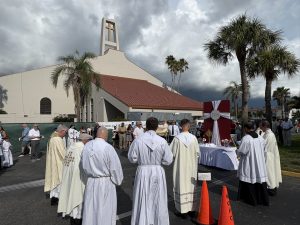
Pope Leo XIV explained the spiritual and missionary meaning of the Eucharistic Procession prior to beginning his own Procession in Rome.
“Together, as shepherds and flock, we will feed on the Blessed Sacrament, adore Him, and carry Him through the streets,” the Holy Father said. “In doing so, we will present Him before the eyes, the consciences, and the hearts of the people.”
Pope Leo XIV called on the faithful to “share the bread” – a sign of the gift of divine salvation – to “multiply hope and to proclaim the coming of God’s kingdom” as he presided for the first time as Pope over Mass for the Solemnity of Corpus Christi.
On the Solemnity when the Catholic Church celebrates especially the mystery of the Eucharist Pope Leo declared: “Christ is God’s answer to our human hunger, because His body is the bread of eternal life: Take this and eat of it, all of you!”
The Holy Father traveled to the Basilica of St. John Lateran, his Cathedral as Bishop of Rome, to celebrate the Mass, which was followed by a Eucharistic Procession along the city’s streets to the Basilica of St. Mary Major.
The Solemnity of Corpus Christi is observed two weeks after Pentecost. The Feast of Pentecost, which took place on June 8 this year, is celebrated 50 days after Easter Sunday, and commemorates the descent of the Holy Spirit upon the Apostles and other followers of Jesus Christ while they were in Jerusalem, as described in the Acts of the Apostles.
In addition, the 2025 Solemnity marks the conclusion of the National Eucharistic Revival, a three-year movement initiated by the U.S. Conference of Catholic Bishops to encourage the faithful to answer the call of Jesus Christ to return to the source and summit of Our Faith – the Real Presence in the Holy Eucharist.
Bishop Dewane advised that the conclusion of the three-year National Eucharistic Revival not be seen as an ending, but a beginning.
“Let us go forth and share the Mystery of the Eucharist with the world,” Bishop Dewane said. “The time is now for us all to be Eucharistic Missionaries, sharing the good news of the Real Presence of Jesus Christ with everyone you know! Non-believers, lapsed Catholics, those on the margins. Bring the saving grace of Christ to the world around you!”













 The response from the faithful of the Eastern Deanery and beyond was impressive, with each host Parish, St. James in Lake Placid, St. Catherine in Sebring, Our Lady of Grace in Avon Park, St. Michael the Archangel in Wauchula, and St. Paul in Arcadia, warmly welcoming the hundreds of pilgrims. While not everyone was able to go to each of the five sites, a core group of about 300 participated in the entire pilgrimage. Some travelled from as far as Naples and Clewiston, while others came from Bradenton, Sarasota and Fort Myers. Three charter buses carried some pilgrims to each stop, and many others traveled in their own vehicles.
The response from the faithful of the Eastern Deanery and beyond was impressive, with each host Parish, St. James in Lake Placid, St. Catherine in Sebring, Our Lady of Grace in Avon Park, St. Michael the Archangel in Wauchula, and St. Paul in Arcadia, warmly welcoming the hundreds of pilgrims. While not everyone was able to go to each of the five sites, a core group of about 300 participated in the entire pilgrimage. Some travelled from as far as Naples and Clewiston, while others came from Bradenton, Sarasota and Fort Myers. Three charter buses carried some pilgrims to each stop, and many others traveled in their own vehicles.
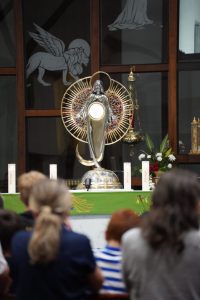 The Office of Youth and Young Adult Outreach is offering Youth Jubilee Adoration Nights as part of the Jubilee Year 2025. The evenings include Eucharistic Adoration, an inspirational talk, prayer, music, and the opportunity to take part in the Sacrament of Reconciliation, all before concluding with Benediction. While the Youth Jubilee Adoration Nights are geared toward younger Catholics, with youth-centric music and talks, all are welcome. Each Adoration Night is 6:30 p.m. to 8:30 p.m. Upcoming opportunities to participate are: Saturday, March 22, St. Patrick Parish, 7900 Bee Ridge Road, Sarasota; and Friday, May 2, St. Paul Parish, 1330 E. Oak. St., Arcadia. There is no cost to attend, but registration is requested at
The Office of Youth and Young Adult Outreach is offering Youth Jubilee Adoration Nights as part of the Jubilee Year 2025. The evenings include Eucharistic Adoration, an inspirational talk, prayer, music, and the opportunity to take part in the Sacrament of Reconciliation, all before concluding with Benediction. While the Youth Jubilee Adoration Nights are geared toward younger Catholics, with youth-centric music and talks, all are welcome. Each Adoration Night is 6:30 p.m. to 8:30 p.m. Upcoming opportunities to participate are: Saturday, March 22, St. Patrick Parish, 7900 Bee Ridge Road, Sarasota; and Friday, May 2, St. Paul Parish, 1330 E. Oak. St., Arcadia. There is no cost to attend, but registration is requested at 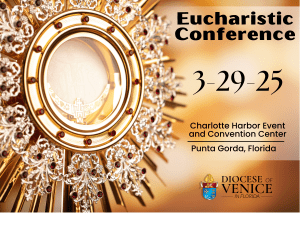 The third Diocese of Venice Eucharistic Conference will take place Saturday, March 29, at the Charlotte Harbor Event and Conference Center in Punta Gorda. The theme for the day-long event is inspired by the Jubilee Year 2025 while also building upon the three-year National Eucharistic Revival. The theme for the Conference is “Becoming Eucharistic Missionaries” into the Jubilee Year 2025, and it offers an opportunity to celebrate the Catholic faith with others.
The third Diocese of Venice Eucharistic Conference will take place Saturday, March 29, at the Charlotte Harbor Event and Conference Center in Punta Gorda. The theme for the day-long event is inspired by the Jubilee Year 2025 while also building upon the three-year National Eucharistic Revival. The theme for the Conference is “Becoming Eucharistic Missionaries” into the Jubilee Year 2025, and it offers an opportunity to celebrate the Catholic faith with others. At Our Lady of Light Parish in Fort Myers, the Pastor, Father Hugh McGuigan, Oblate of St. Francis de Sales, explained the importance of the Solemnity as a “celebration of the fulfillment of God’s great desire to be one with His people – to establish an everlasting covenant with us – a covenant which guarantees our forgiveness and reconciliation.”
At Our Lady of Light Parish in Fort Myers, the Pastor, Father Hugh McGuigan, Oblate of St. Francis de Sales, explained the importance of the Solemnity as a “celebration of the fulfillment of God’s great desire to be one with His people – to establish an everlasting covenant with us – a covenant which guarantees our forgiveness and reconciliation.”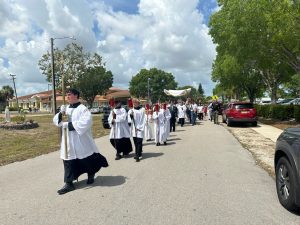

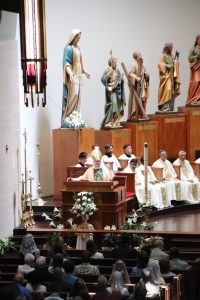
 “Take the grace that the Lord gives each of us, and live it and go forward,” the Bishop said. “We learn the important lesson that nothing is ‘impossible for God.’ Mary said, ‘Behold, I am the handmaid of the Lord. May it be done to me according to your word.’ Then the angel departed from her’ (Luke 1:37-38). Without God, we cannot fulfill His Mission. Our Lady understood that, so must each one of us. We have to radically change our inner selves and have that same strength to do the will of the Lord.”
“Take the grace that the Lord gives each of us, and live it and go forward,” the Bishop said. “We learn the important lesson that nothing is ‘impossible for God.’ Mary said, ‘Behold, I am the handmaid of the Lord. May it be done to me according to your word.’ Then the angel departed from her’ (Luke 1:37-38). Without God, we cannot fulfill His Mission. Our Lady understood that, so must each one of us. We have to radically change our inner selves and have that same strength to do the will of the Lord.”
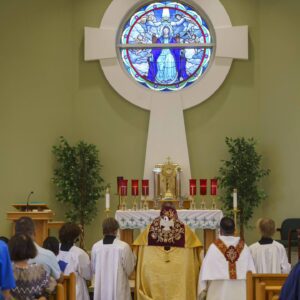
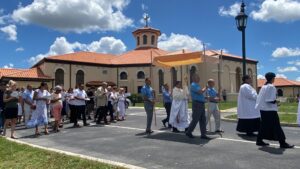
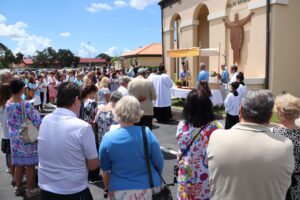

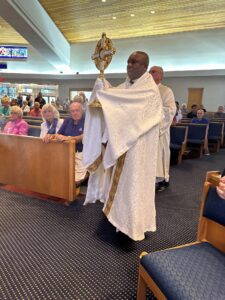 After the celebration of the 10:45 a.m. Mass at San Pedro, the Corpus Christi procession began with the placement of a consecrated host in the monstrance (a sacred vessel that displays the sacred host to the faithful). After a brief time for all to pray before the Most Holy Eucharist, the procession, led by altar servers carrying candles and an incenser, began. Father Marzione carried the monstrance with the Blessed Sacrament. Proceeding out of the church, the faithful followed; members of the Knights of Columbus escorted the Blessed Sacrament by carrying the canopy.
After the celebration of the 10:45 a.m. Mass at San Pedro, the Corpus Christi procession began with the placement of a consecrated host in the monstrance (a sacred vessel that displays the sacred host to the faithful). After a brief time for all to pray before the Most Holy Eucharist, the procession, led by altar servers carrying candles and an incenser, began. Father Marzione carried the monstrance with the Blessed Sacrament. Proceeding out of the church, the faithful followed; members of the Knights of Columbus escorted the Blessed Sacrament by carrying the canopy.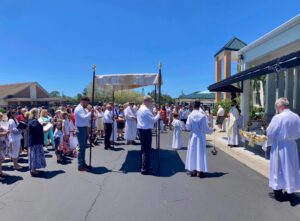 The canopy serves a dual purpose. On one hand, it protects the Blessed Sacrament against anything that might fall on it, including light rain, creating a “sacred space” that is reserved for the priest carrying the monstrance. Secondarily, the faithful in the large crowd can locate the Blessed Sacrament at the head of the procession more easily.
The canopy serves a dual purpose. On one hand, it protects the Blessed Sacrament against anything that might fall on it, including light rain, creating a “sacred space” that is reserved for the priest carrying the monstrance. Secondarily, the faithful in the large crowd can locate the Blessed Sacrament at the head of the procession more easily.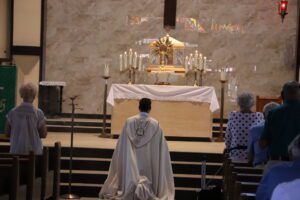
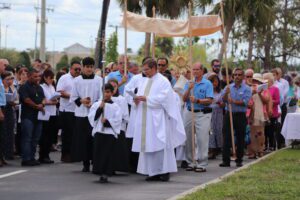
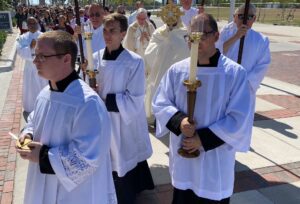
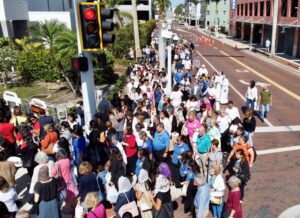
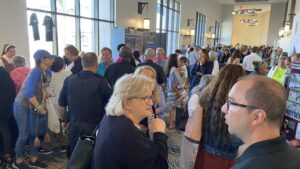

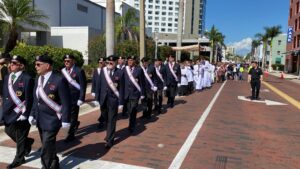
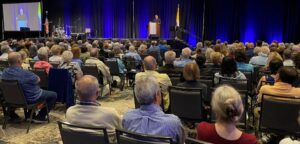
 Speaking to both the English and Spanish participants was Hector Molina who focused on “The Eucharist as a Sacrifice, Real Presence, and Holy Communion,” and then “Men of the Eucharist: Taken, Blessed, Broken & Given.”
Speaking to both the English and Spanish participants was Hector Molina who focused on “The Eucharist as a Sacrifice, Real Presence, and Holy Communion,” and then “Men of the Eucharist: Taken, Blessed, Broken & Given.” Also speaking to the Spanish track, was Joel de Loera, who focused on “The Eucharist: Strength and Joy of the Family,” and then “Men as Spiritual Leaders and Defenders of the Faith.” Mary Ann Weisinger-Puig spoke on the topic, “This is My Body Given Up for You,” and then on “Drawing Close to Jesus in the Eucharist: Meditations on Sacred Art.” Meanwhile, Martha Fernandez-Sardina talked about “The Eucharist and the Feminine Genius.”
Also speaking to the Spanish track, was Joel de Loera, who focused on “The Eucharist: Strength and Joy of the Family,” and then “Men as Spiritual Leaders and Defenders of the Faith.” Mary Ann Weisinger-Puig spoke on the topic, “This is My Body Given Up for You,” and then on “Drawing Close to Jesus in the Eucharist: Meditations on Sacred Art.” Meanwhile, Martha Fernandez-Sardina talked about “The Eucharist and the Feminine Genius.”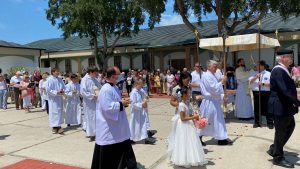 “The power of Our Lord, and His Presence in the Blessed Sacrament, brings me great comfort,” Dwyer said. “I feel so happy to be able to honor Jesus in this special way.”
“The power of Our Lord, and His Presence in the Blessed Sacrament, brings me great comfort,” Dwyer said. “I feel so happy to be able to honor Jesus in this special way.” The procession made its way from the main church into the Parish courtyard and then into the parking lot, stopping at four temporary altars where Father Scanlan led everyone in prayer and readings from the Gospel. The procession concluded in the Parish Chapel where Father led the Benediction.
The procession made its way from the main church into the Parish courtyard and then into the parking lot, stopping at four temporary altars where Father Scanlan led everyone in prayer and readings from the Gospel. The procession concluded in the Parish Chapel where Father led the Benediction. “Brothers and sisters, Our God dwells among us,” Father said during the Mass. “He comes to honor us. To strengthen and heal us… But, the Lord can only do so much, unless we open our hearts to Him. We can say Lord, help me to believe; help me to receive You with love and affection; help me to allow you to heal me and to transform me, this heart and soul of mine. He wants so much for us to encounter Him, here today, each one of us. Brothers and sisters, this Great Feast offers us the opportunity to rekindle our love and our wonder and our gratitude of the Presence of Jesus in the Blessed Sacrament. He is here. He is here.”
“Brothers and sisters, Our God dwells among us,” Father said during the Mass. “He comes to honor us. To strengthen and heal us… But, the Lord can only do so much, unless we open our hearts to Him. We can say Lord, help me to believe; help me to receive You with love and affection; help me to allow you to heal me and to transform me, this heart and soul of mine. He wants so much for us to encounter Him, here today, each one of us. Brothers and sisters, this Great Feast offers us the opportunity to rekindle our love and our wonder and our gratitude of the Presence of Jesus in the Blessed Sacrament. He is here. He is here.”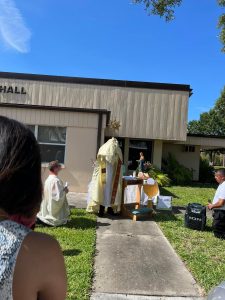 The Feast Day is an important affirmation of our belief that Our Lord is really and truly sacramentally present in the form of bread and wine. When Our Lord instituted the Eucharist, He said this IS My Body and this IS My Blood; not this represents or is symbolic of my body and blood. The Sacrament was defined as “an outward sign” of inward grace given to us by Jesus Christ for our sanctification and salvation.
The Feast Day is an important affirmation of our belief that Our Lord is really and truly sacramentally present in the form of bread and wine. When Our Lord instituted the Eucharist, He said this IS My Body and this IS My Blood; not this represents or is symbolic of my body and blood. The Sacrament was defined as “an outward sign” of inward grace given to us by Jesus Christ for our sanctification and salvation.